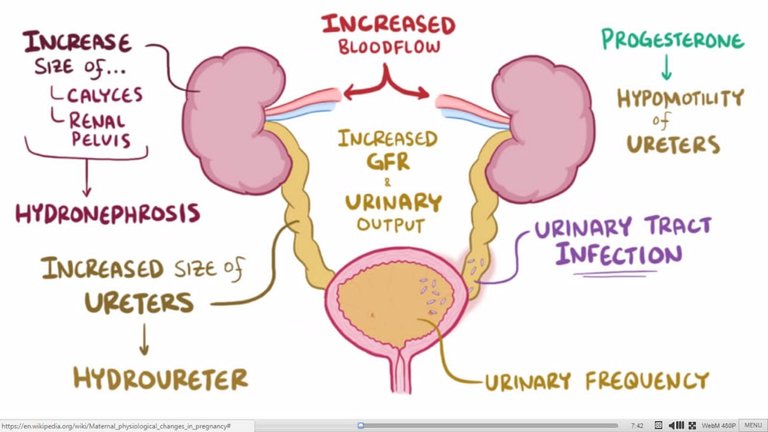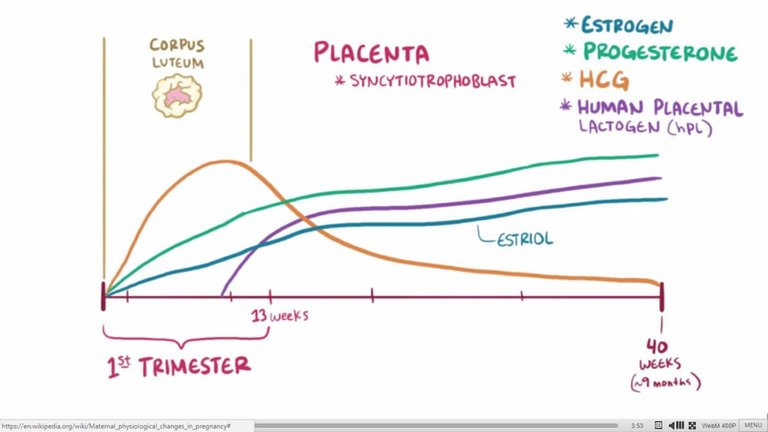Sadly, we can’t do that here, we just have to be formal here.
I decided to take a break from medical-related posts since my break started just so I can rest my head off the stress from writing exams after an 8 months break from school. Well, I’m back to continuing my midwifery series and today, we will get to know about the PHYSIOLOGICAL CHANGES DURING PREGNANCY.
Countless times, I’ve got to give answers to questions asked by some people, especially men. They’ll be like “I’ve never seen a Pregnant woman without swollen legs, why is that? or the usual Nurse, why is it that my wife’s skin got darker now she is pregnant.”
Pregnancy is a very delicate and complex journey that affects not only the physical but also the psychological well-being of a woman.
The article will focus on the major body systems that are affected during pregnancy. It will explain the reason behind the swollen legs, dark necks, frequent urination, fast breathing, and the like.

By Osmosis - open.osmosis.org, CC BY-SA 4.0, Wikimedia
In no particular order, I’ll like to start with the Renal/Urinary system. The major organs here are the kidney and bladder.
During pregnancy, renal action (The function of the kidney) increases due to increase blood volume. Please note that blood flow increases as a way to compensate for blood loss during delivery and also, due to the flow of accumulated fluid during pregnancy. Hence increase in blood flow enhances renal action which helps to aid the excretion of waste products. The kidney also retains more water which accounts for the swellings seem especially around the hand and feet.
Furthermore, the size of the kidney increases during pregnancy. Due to the weight of the abdomen and the increased uterus on the bladder, it reduces in size resulting in more frequent urination.

By Osmosis - open.osmosis.org, CC BY-SA 4.0, Wikimedia
Next is the Endocrine System.
During pregnancy, progesterone and estrogen increases due to the presence of Human Chorionic Gonadotropin Hormone (HCG) casually called the pregnancy hormone. It is produced by the placenta during pregnancy. HCG is actually what is tested for when a pregnancy test is done.
While progesterone helps the growth of the uterus and also prevents contraction (this prevents miscarriage in a normal situation) while estrogen aids the development of the placenta.
Let’s dive into the Circulatory and Cardiovascular systems.
As a means to compensate for blood loss during delivery, there is an increase in blood volume during pregnancy. This indirectly helps to curb the risk of hypovolemic shock during delivery. Increased circulatory estrogen, progesterone, and prostaglandin relax vascular smooth muscle. Relaxation of smooth muscles increases blood circulation.
Also, white blood cells increase due to inflammation and pain experienced in pregnancy. Remember white blood cells are casually called the body soldiers. They help to fight against microorganisms. This is important because due to the suppression of the immune system, a pregnant woman is at high risk of contracting infections and diseases.
Next is the Respiratory system which explains one of the most visible symptoms of pregnancy. During pregnancy, the diaphragm gets elevated as pregnancy processes. This leads to difficulty breathing especially in 3rd trimester (6th month to delivery). Diaphragm descends after the delivery hence normal respiration of restored.
Let’s now talk about the Gastrointestinal Tract, During Pregnancy, there is increased hunger and thirst which helps to balance the increased fluid loss. Progesterone relaxes the lower esophageal sphincter. This is like a valve that prevents the backflow of food substances into the esophagus. Due to the effect of progesterone, the action of the lower esophageal sphincter reduces which leads to reflux of gastrointestinal content which ultimately leads to heartburn. There is also decreased abdominal tone which reduces bowel movement thereby posing risk for constipation.

By Humanitate eta Hezkuntza Zientzien Fakultatea - Own work, CC BY-SA 4.0, Wikimedia
Generally, there is an increased metabolic rate, increase insulin resistance (which poses a risk of hyperglycemia), and fat deposition which accounts for the increased weight gain of about 13kg. The general body metabolic rate increases from 10% to 20%.
You must have wondered why pregnant women seem to tilt backward as the pregnancy progresses and the fetus increases in size. This is medically known as Lordosis. It is characterized by the inward curvature of the spine. It occurs as a result of the adjustment of the spine to realign the center of gravity.
So In summary, pregnancy is a complex process comprising different steps interacting with one another. These above are the physiological changes that take place in pregnancy. These changes account for the signs and symptoms of pregnancy.
I tried as much as possible to simplify the pathophysiology of these processes. I hope this gives you a clear understanding of the physiological changes that take place in pregnancy. Thank you.

References
Endocrine changes in Pregnancy
Cardiovascular Changes in Pregnancy
Circulatory Chages in Pregnancy
Urinary Changes in Pregnancy




